What are the best grow bags for lettuce? It’s a question that could inspire hours of debate and research. We can make finding the right grow bag a little easier. How? By providing you with 5 of our favorite choices.
We’ve narrowed down the bestgrow bags for lettuce, complete with pros and cons for each, important factors to consider when buying it, and common mistakes to avoid while growing lettuce so that you get the results you’re really looking for.
Let’s dive in!
Contents
How We Chose The Best Grow Bags
We chose the best grow bags by considering several factors: durability, material, size, and drainage. We also looked at customer reviews and ratings to see which grow bags had the highest satisfaction among users.
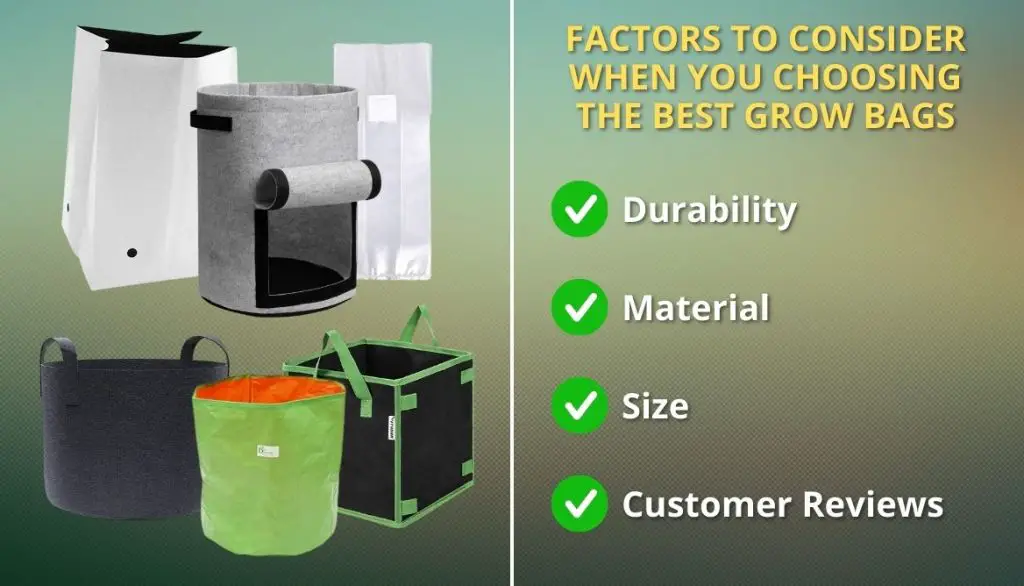
1. Durability
The first thing we looked at was how long these grow bags would last so we wouldn’t have to replace them as often. The average life span of a grow bag gardening is two years, but some can last up to five years.
2. Material
There are different types of materials that can be used in making a grow bag, including PVC or vinyl however, vinyl is more durable than PVC and has a better resistance against wear and tear.
3. Size
The grow bag size for lettuce is 3-gallon size and can stretch to 7 gallons if you wish to plant a bigger bundle.
4. Customer Reviews
Finally, customer reviews and ratings are very important. Look at our top picks section where we have compiled the best-rated and reviewed fabric grow bags.
Best Grow Bags For Lettuce: Our Top Picks
VIVOSUN 5-Pack 3 Gallon Square | JERIA 12-Pack 7 Gallon | OPULENT SYSTEMS 5-Pack 5 Gallon | |
Material: | Heavy-duty, breathable | Polypropylene | Non-woven fabric grow bags |
Size: | 5 gallons | 7 gallons | 5 gallons |
Drainage: | Multiple drainage holes | Built-in | Bottom drain holes |
Durability: | Strong and long-lasting | Reinforced corners for added strength | Strong |
Additional Features: | Handles for easy transport | UV resistant | Reinforced handles |
1. VIVOSUN 5-Pack 3 Gallon Square Fabric Grow Bags
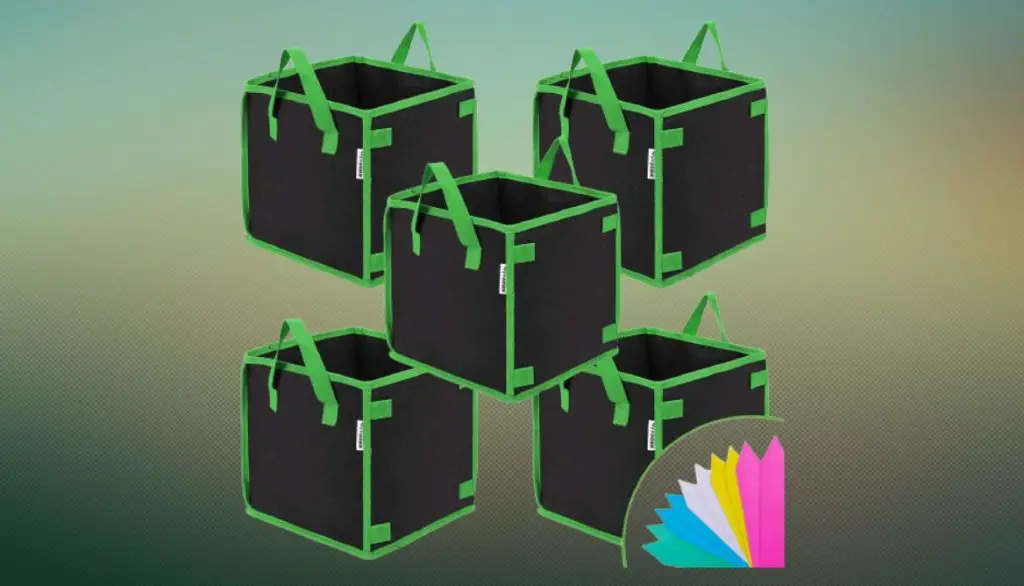
Material: | Thick Nonwoven Fabric |
Size: | 3 Gallons |
Drainage: | Bottom Drain Holes |
Durability: | Durable and Reusable |
Additional Features: | Reinforced Handles for easy transport and hanging |
Are you looking for a convenient and easy way to start your own vegetable or flower garden? Look no further than the VIVOSUN 5-Pack of 3-Gallon Square Grow Bags offer a number of benefits for both novice and experienced gardeners.
- Thick nonwoven fabric material
- Durable and long-lasting.
- Perfect for small-scale gardening.
- Bottom drain holes for drainage.
- Reinforced handles
- May not be suitable for larger plants
In conclusion, the VIVOSUN 5-Pack 3 Gallon Square Grow Bags are an excellent choice for small-scale gardening.
2. OPULENT SYSTEMS 5-Pack 5 Gallon Grow Bags
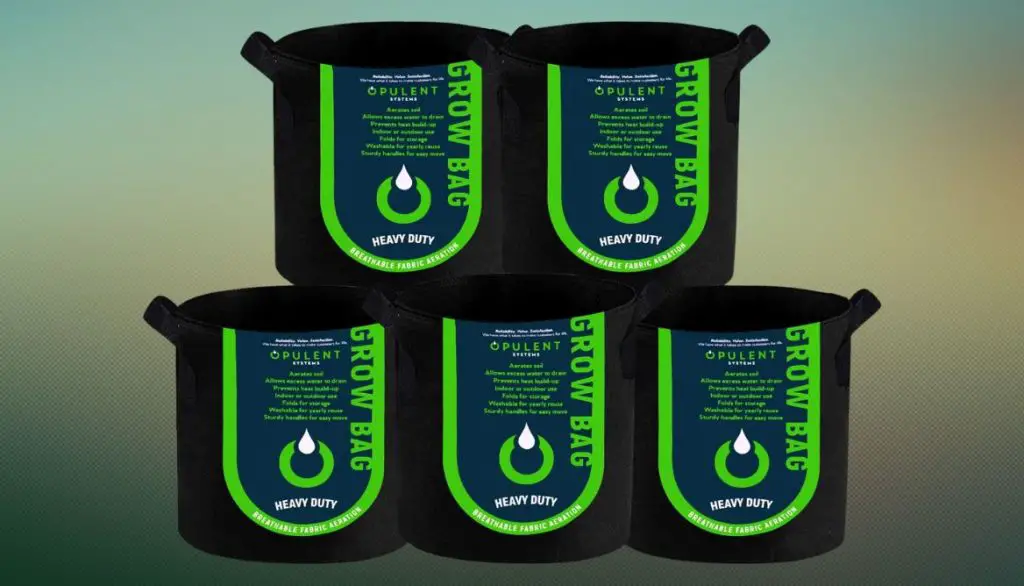
Material: | Heavy-Duty, Breathable Fabric grow bags |
Size: | 5 Gallons |
Drainage: | Multiple Drainage Holes |
Durability: | Strong and Long-lasting |
Additional Features: | Handles for easy transport |
If you’re looking for a heavy-duty option for your gardening needs then go for OPULENT SYSTEMS 5-Pack of 5 Gallon Grow Bags. These grow bags are designed to handle larger plants and provide a number of benefits for experienced gardeners.
- Heavy-duty, breathable fabric material
- Perfect for larger plants
- Multiple drainage holes allow for drainage
- Handles make it easy to transport the grow bags
- May not be suitable for smaller plants
- More expensive than some other options on the market.
In conclusion, the OPULENT SYSTEMS 5-Pack 5 Gallon Grow Bags are an excellent choice for experienced gardeners who are looking for a heavy-duty option for their larger plants.
3. Nicheo 3 Pcs 7 Gallon Garden Bags
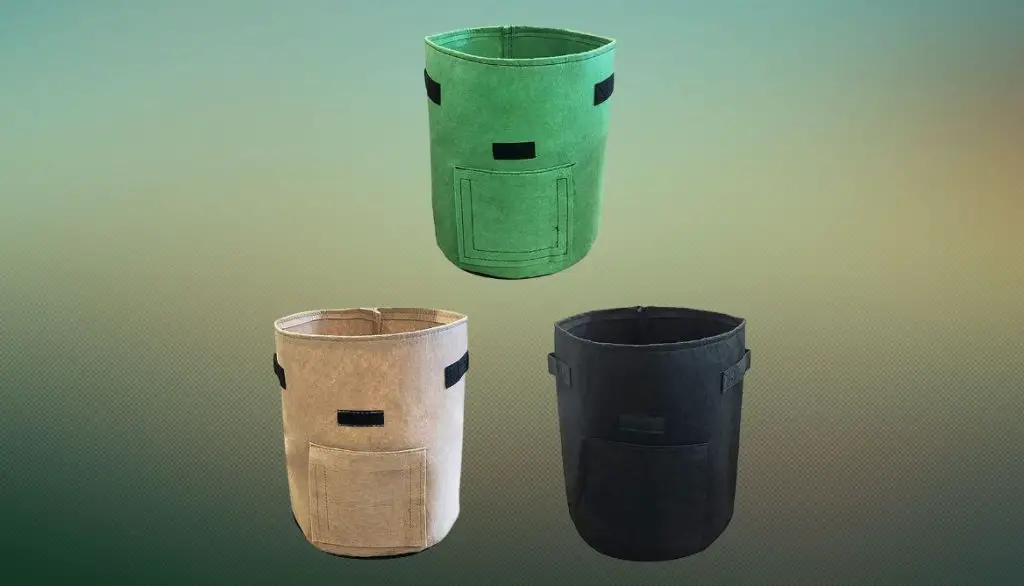
Material: | Non-woven Fabric |
Size: | 7 Gallons |
Drainage: | Breathable strong water permeability |
Durability: | Long Lasting |
Additional Features: | Easy-to-harvest planter pot with handles for easy transport |
The Nicheo 3 Pcs 7 Gallon Garden Bags are a great choice if you want to grow your plants in large containers. They’re made from high-quality materials and are designed to last. You can use these grow bags in a variety of ways, including as planter pots or as a grow bag for your plants.
- Large size suitable for larger plants
- Easy-to-harvest design
- Durable and long-lasting
- Handles for easy transport
- Great value for money
- May not be suitable for smaller plants
- Could be more expensive than some other options on the market
If you’re looking for something durable and cost-effective, consider the Nicheo 3 Pcs 7 Gallon Garden Bags!
4. VIVOSUN 5-Pack 1 Gallon Fabric Grow Bag
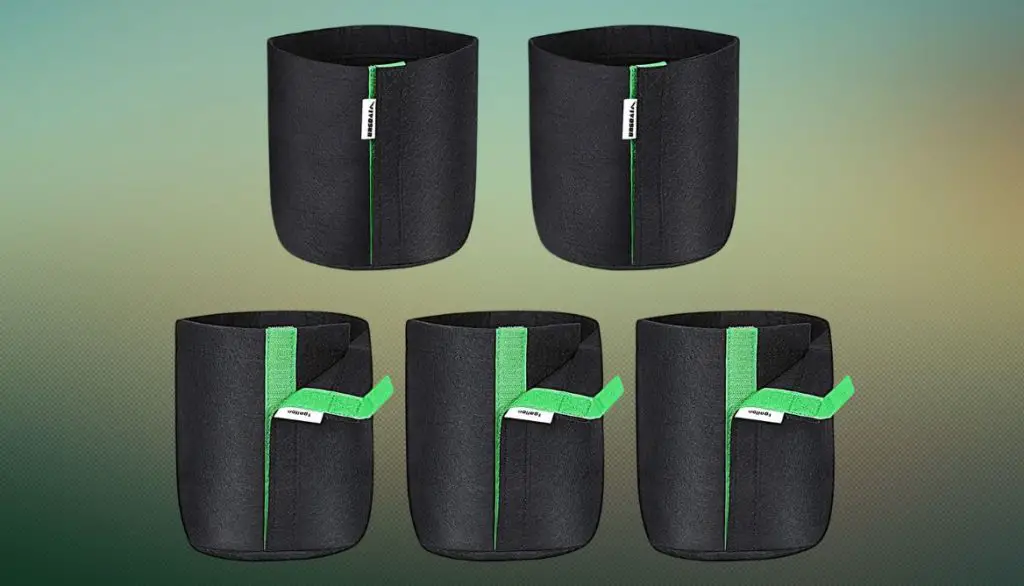
Material: | Fabric Pots with Self-Containing Bottom |
Size: | 1 Gallon |
Drainage: | Self-containing bottom |
Durability: | Durable and reusable |
Additional Features: | Reusable Bag |
The VIVOSUN 5-Pack 1 Gallon Grow Bags are a great choice for this kind of gardening because they come in a variety of sizes and materials, from fabric pots with self-contained bottoms to durable plastics with reusable bottoms.
- The self-containing bottom allows for proper drainage
- 1-gallon size is perfect for small-scale gardening
- Great value for money
- Durable and reusable
- Not be suitable for larger plants
- Bags may be less durable than some other options
5. JERIA 12-Pack 7 Gallon Vegetable/Flower/Plant Bags
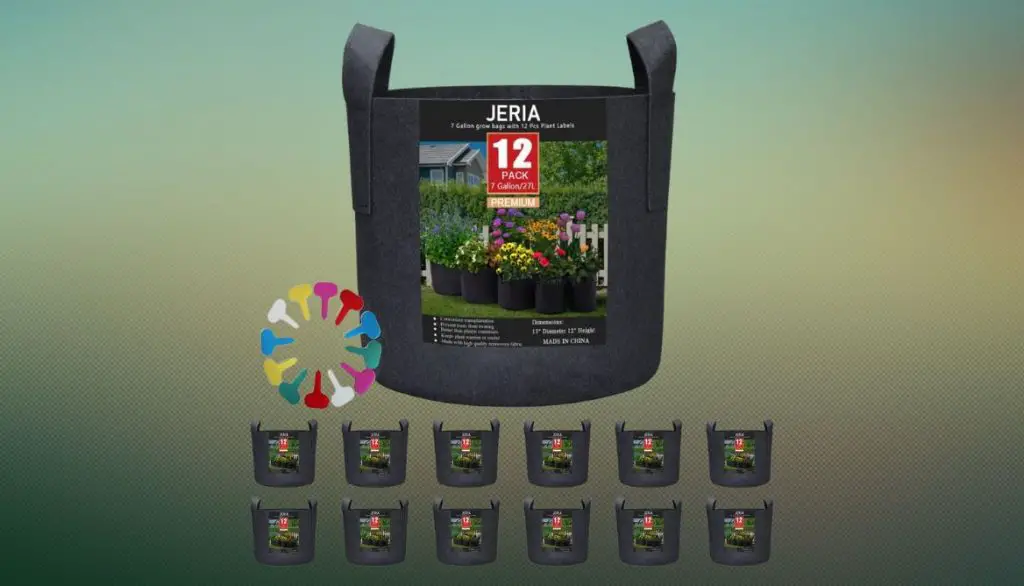
Material: | High-Quality Fabric |
Size: | 7 Gallons |
Drainage: | Self-water drainage bottom |
Durability: | Durable and recyclable |
Additional Features: | Reusable Bag with X-shaped stitching |
Vegetable/Flower/Plant Grow Bags are great for growing small plants and flowers in your home. The bags are made of high-quality fabric and have a tensile strength rating of 3,000 lbs.
These bags can hold up to 7 gallons of vegetables which is great if you want to grow an entire garden full of different types of plants all at once!
- Made with high-quality plastic
- Large enough to hold large amounts
- The bags are made from food-grade materials.
- Difficult to fit into some small spaces
How To Grow Leaf Lettuce In A Reusable Grocery Bag
Grow bags are an easy way to start growing your own vegetables at home or on the go. They’re also reusable, so you can save money by reusing them over and over again!
Grow Bag Options
Grow bags come in many different sizes, shapes, materials, and colors. Choose one that’s both environment-friendly and economical.
The size of the grow bag gardening will depend on what type you choose, but bags come in sizes ranging from 34 inches long, to 25 inches wide by 10 inches tall (about 715 mm x 635 mm x 250 mm).
There are four main types of grow bags:
- Polyethylene
- Polypropylene
- Polystyrene
- Nylon.
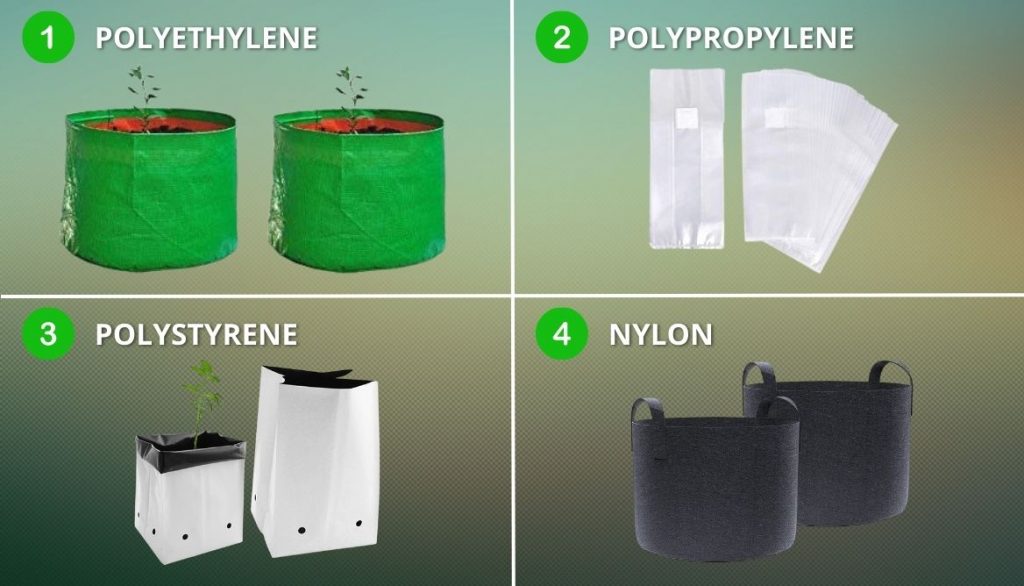
Polypropylene and polyethylene are biodegradable and can be composted at home while polystyrene is not biodegradable at all and must be disposed of properly.
Nylon can be recycled but will break down into smaller pieces over time which could contaminate potting soil.
What You’ll Need
Equipment/Tools
- Scissors
- Drill
- Potting mix
- Fertilizer
Materials
- Reusable grocery bag
- Leaf lettuce seedlings
Instructions
We will walk you through the step-by-step process of how to grow leaf lettuce in a reusable grocery bag.
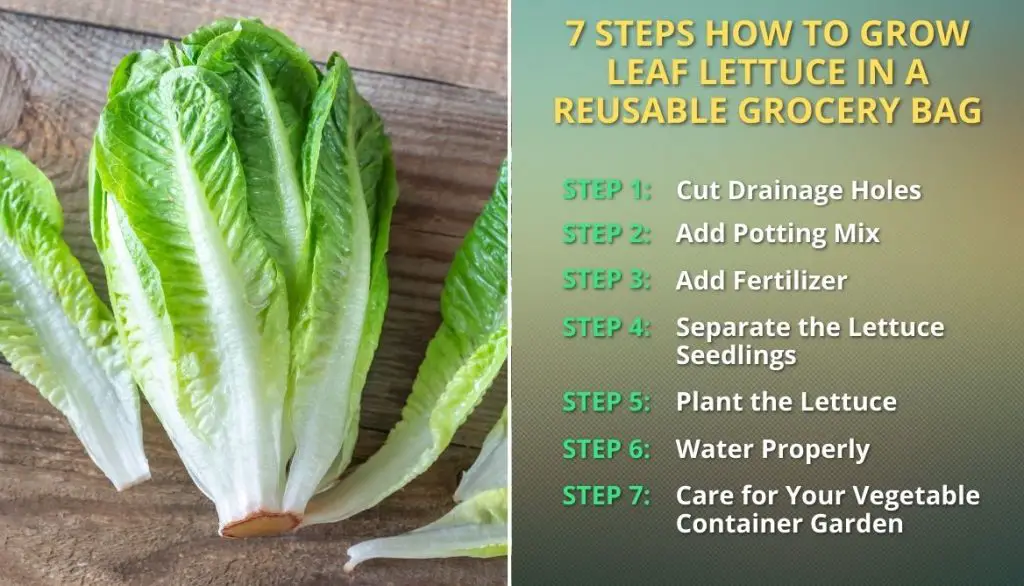
Step 1: Cut Drainage Holes
Cut a hole in the bottom of the bag that is large enough to allow water to drain out. You can use a sharp knife or scissors to make the hole, but make sure you do not cut any holes in the sides of your bag.
Step 2: Add Potting Mix
Add potting mix to fill up roughly half of your container garden, being sure not to add too much as it could cause problems with drainage.
Step 3: Add Fertilizer
Add compost or fertilizer according to package instructions and mix thoroughly with your hands before adding it to your container garden.
Step 4: Separate the Lettuce Seedlings
Separate lettuce seeds from their mounds and place them in pots or containers so that each seedling has room around it for roots and shoots to grow properly without crowding each other out or having an uneven amount of space around them (which will lead to poor growth).
Step 5: Plant the Lettuce
Carefully plant your lettuce seedlings in the potting mix, spacing them about 6 inches apart. Press down lightly on the soil moist to firm it around the seedlings.
Step 6: Water Properly
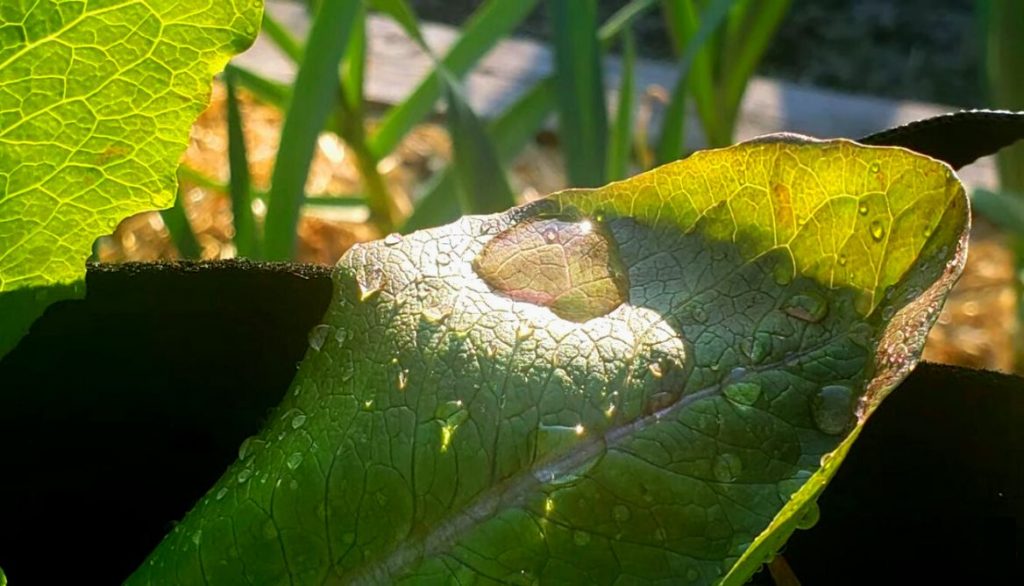
Water your lettuce seedlings thoroughly to ensure that the potting mix is evenly moist in the grown bag gardening. Keep an eye on the moisture level, and water as needed to keep the potting soil consistently moist but not waterlogged.
Step 7: Care for Your Vegetable Container Garden
As your lettuce grows, it will need regular care to ensure that it thrives. This includes maintaining proper moisture levels, fertilizing, and controlling pests. Keep an eye out for signs of disease or insect infestation and take action promptly if you notice any issues.
How To Grow Lettuce In Grow Bags
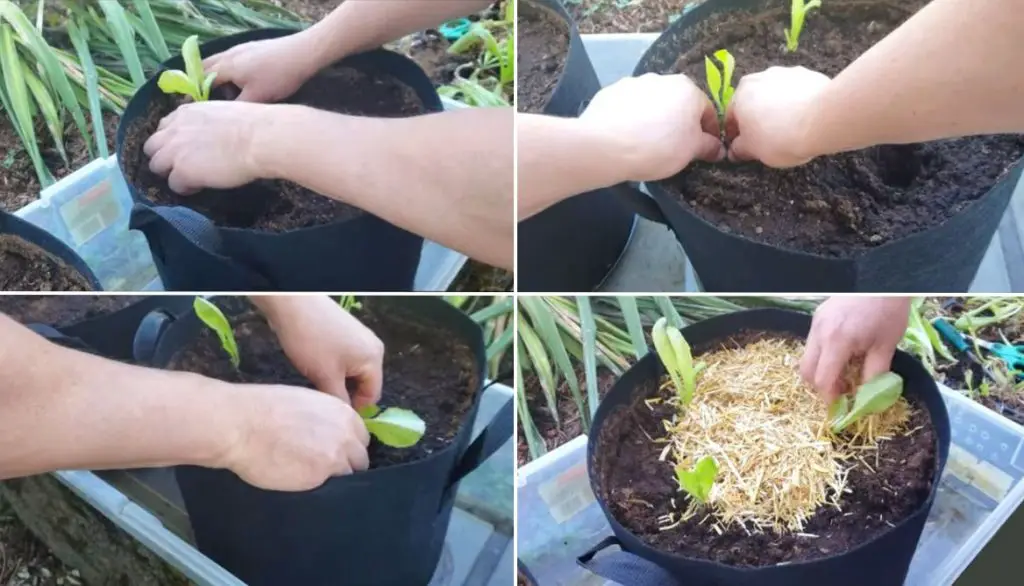
Growing lettuce in grow bags is a great way to have fresh, homegrown lettuce all season long. In this blog post, we will walk you through the step-by-step process of how to grow lettuce in grow bags.
1. Choose The Right To Grow Bag Gardening
Before you start, you’ll need to choose the right grow bag for your lettuce. Look for a bag that is specifically designed for lettuce and is the right size for your space.
2. Prepare The Grow Bag
Once you have your grow bag, prepare it by cutting drainage holes in the bottom. This will allow excess water to drain out, preventing waterlogging.
3. Fill The Bag With Potting Mix
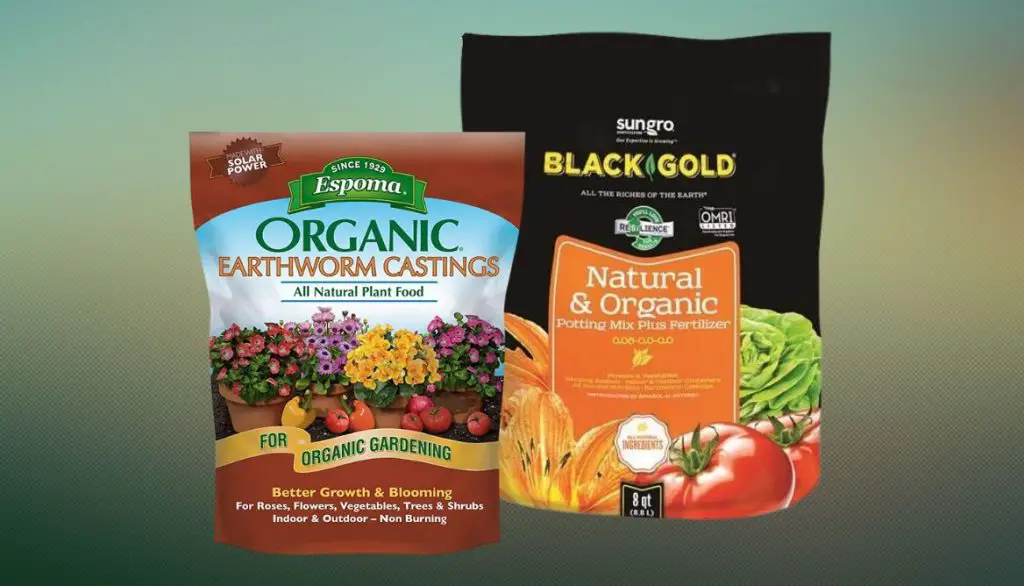
Fill the grow bag with a high-quality potting mix. This will provide the perfect growing environment for your lettuce root systems.
4. Add Fertilizer
To ensure that your lettuce has all the necessary nutrients to grow, you’ll need to add fertilizer to the potting mix. You can use a slow-release fertilizer that will last for several weeks or a liquid fertilizer that you can apply every 2-3 weeks.
5. Plant The Lettuce Seedlings
Carefully plant your lettuce seedlings in the potting mix, spacing them about 6 inches apart. Press down lightly on the soil to firm it around the seedlings.
6. Water Properly
Water your lettuce seedlings thoroughly to ensure that the potting mix is evenly moist. Keep an eye on the moisture level and water as needed to keep the soil moist consistently but not waterlogged.
7. Care For Your Lettuce
As your lettuce grows, it will need regular care to ensure that it thrives with air pruning. This includes maintaining proper moisture levels, fertilizing, and controlling pests.
Why Use Grow Bags To Grow Lettuce
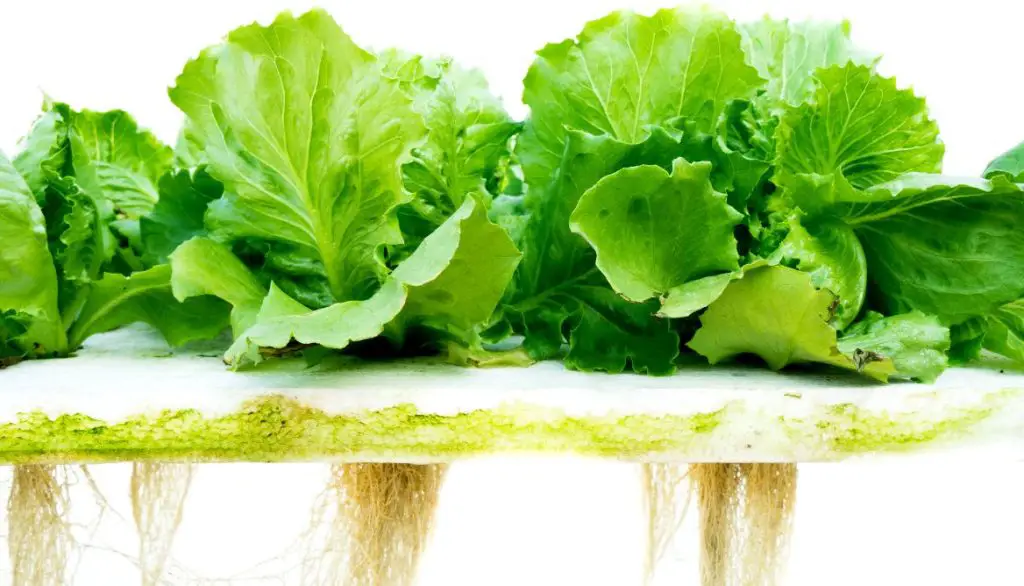
Grow bags are a space-saving solution to traditional gardening, which requires more space than most people have. Using it will help growing plants that are healthy and thrive in their environment.
1. Space Saving
Grow bags are made as a space-saving option for gardening. They are made of a material that allows for good root growth and they are easy to use, which makes them a great solution for small gardens or balconies.
2. Better Root Growth
Grow bags allow for better root growth than traditional in-ground gardening by air pruning. In addition, they allow for easier access to plants.
3. Less Cost
The cost of using grow bags is less than traditional in-ground gardening. This is because grow bags can be recycled after being used and reused for several growing season, whereas an in-ground garden would need new supplies each year (such as soil).
3 Common Mistakes To Avoid While Growing Lettuce
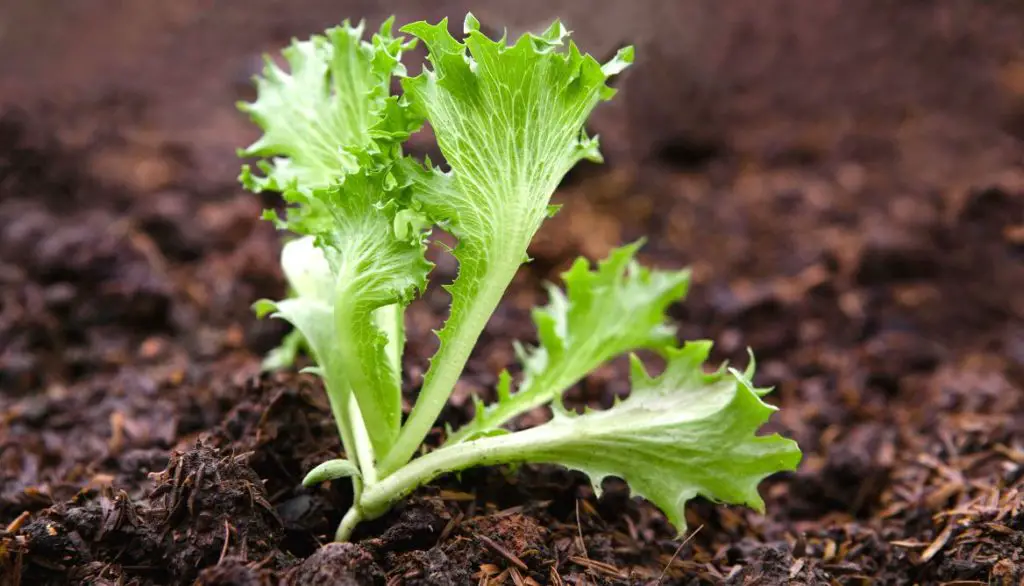
Don’t let these 3 mistakes get in your way of growing a bountiful harvest of lettuce in your garden:
1. Planting Seeds Too Densely
The ideal spacing for lettuce is about 18 inches apart, but if you plant them too close together, they will not be able to grow as well.
To prevent this from occurring, take away some of the plants in grow bag gardening and replant them in a more suitable location.
2. Choosing A Location That Is Too Hot
Lettuce needs cool temperatures in order to grow well; however, if the temperature outside is above 70 degrees Fahrenheit (21 degrees Celsius) then it will not be able to grow properly.
3. Letting Your Lettuce Dry Out
Lettuce leaves are extremely sensitive to water loss, so it’s important not to let them dry out for too long before watering them again. You should water them thoroughly each time you water your garden or lawn so that any excess moisture doesn’t evaporate.
Gardening In Grow Bags: Advantages And Disadvantages
Grow bag gardening is widely used by beginner gardeners as well as experienced gardeners who want to experiment with hydroponics without investing in a large system or needing professional equipment during growing season.
- Space-saving solution
- Better Root Growth
- Ease of use
- Cost-effective
- Flexibility in the location of gardening.
- Limited root growth as compared to in-ground gardening
- Need to replant the seedlings on a regular basis
- Limited in size and may not be suitable for larger plants
- Need to maintain proper moisture and temperature level
- Limited in providing the necessary nutrients to the plant
What To Consider When Choosing The Best Grow Bag
1. Material
The grow bags are made of breathable material with some form of insulation for the heat.
2. Size
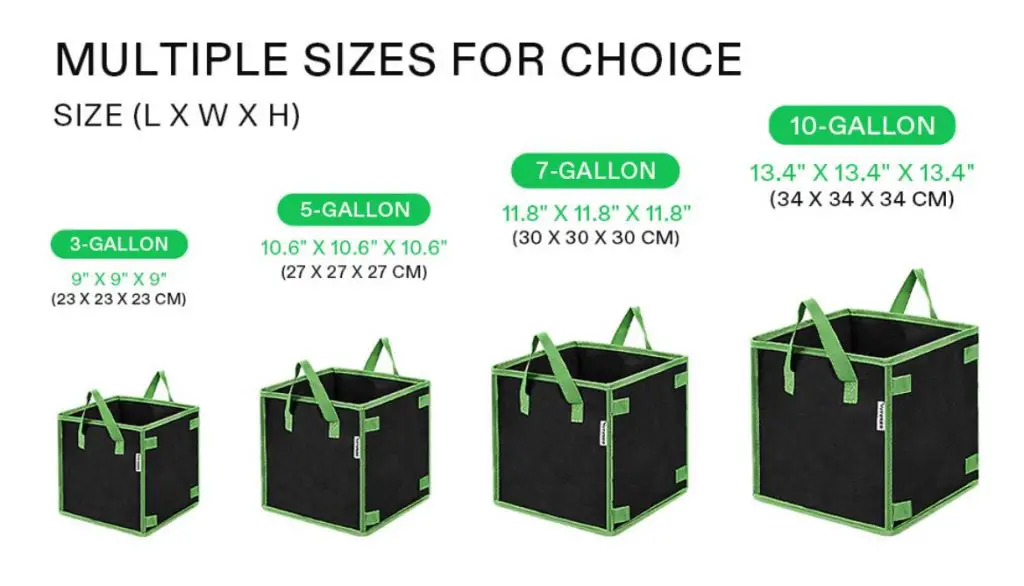
A good size for a grow bag should be able to fit two plants in there comfortably.
A good rule of thumb is to make sure that the top half of the bag has at least an inch of space between its lid and the top of your pot so that plants don’t dry out during transport or storage.
3. Aeration And Drainage
Aeration and drainage are important factors when choosing your grow bag. The more holes or vents there are in your grow bag, the more air it will hold, which means more water will drain out of it as well (and vice versa).
4. Windows
A grow bag with a single window is ideal because it allows you to see everything that’s going on inside. This can be useful if you want to make sure that your plants are getting enough light and nutrients.
5. Transplanting
You may need to transport your plants from time to time, so it’s important that your own grow bags are portable and easy to move around.
6. Portability
The grow bag you choose should be one that is portable and easy to carry. If this is the case, ensure the bag has handles on each side.
Our Verdict
We have had the opportunity to work with many different types of grow bags, and we have found that the best grow bag for growing lettuce is the VIVOSUN 5-Pack 3 Gallon Square Grow Bags.
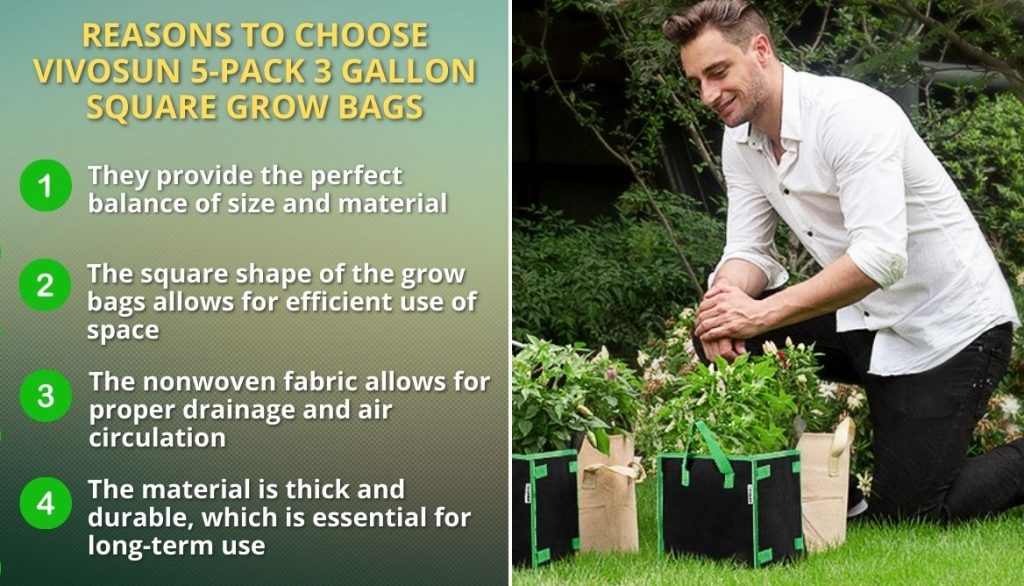
The reason we recommend these grow bags is that:
- They provide the perfect balance of size and material.
- The square shape of the grow bags allows for efficient use of space, which is especially beneficial for those with smaller gardens or balconies.
- The nonwoven fabric of these grow bags is also perfect for lettuce. It allows for proper drainage and air circulation, promoting healthy root growth.
- Additionally, the material is thick and durable, which is essential for long-term use.
The VIVOSUN 1 Gallon Grow Bags are also suitable for small plants, but their size and self-contained watering system may not be suitable for larger plants.
JERIA 12-Pack and Nicheo Garden Bags are also good options for growing lettuce as they are of good size and made of nonwoven fabric that allows for proper drainage and air circulation.
FAQ
What Size Grow Bag Do I Need For Lettuce?
To grow lettuce at home, you’ll need a grow bag that’s at least 3 feet by 3 feet. This will give your lettuce room to grow without being crowded.
How Many Lettuce In A Grow Bag?
We recommend filling your grow bags with 1-2 seeds per bag.
What Is The Best Container For Lettuce?
The best container for growing lettuce is a large, wide-mouth, wheeled bin that can be filled with soil.
Can Lettuce Be Grown In Grow Bags?
Yes, lettuce can be grown in grow bags as it’s roots are only 12 to 18 inches long.
What Is The Fastest Way To Grow Lettuce?
The fastest way to grow lettuce is by using a hydroponic system. This method allows you to provide your lettuce with the nutrients it needs without the use of soil.
How Many Times Will Lettuce Regrow?
The number of times lettuce will regrow depends on a number of factors, but typically we see it regrow three to five times per season.
Conclusion
When it comes to growing lettuce in grow bags, there are several options available on the market. However, after researching and comparing some of the top grow bags, we have found that the VIVOSUN 5-Pack 3 Gallon Square Grow Bags are the best choice for growing lettuce.
These grow bags offer the perfect balance of size and material, promoting healthy root growth and allowing for efficient use of space.
What tips do you have for growing lettuce in grow bags? Let us know in the comment section below.
- Best Grow Bags For Lettuce: 6 Things To Consider Before Buying! - January 23, 2023
- Can A Snowblower Remove Ice: Best Ice Breaking Technique Revealed! - December 30, 2022
- What Is The Best Gas For A Snowblower? - January 12, 2022

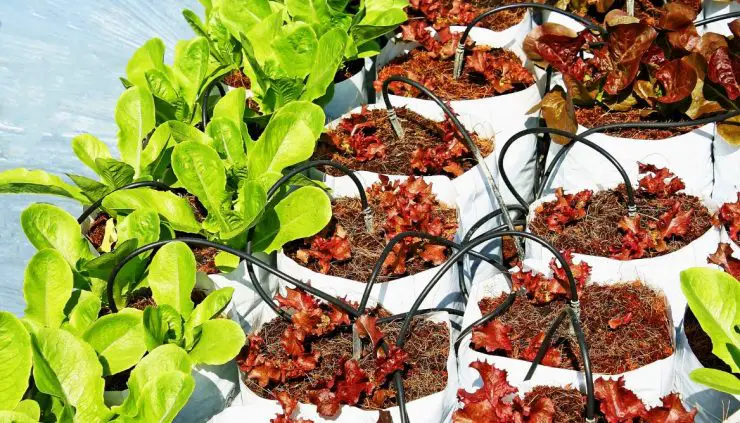

Add comment